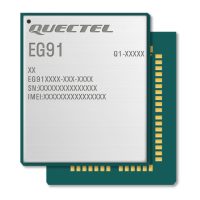
Do you have a question about the Quectel EG91 Series and is the answer not in the manual?
| Brand | Quectel |
|---|---|
| Model | EG91 Series |
| Category | Control Unit |
| Language | English |
Essential safety precautions for operating the EG91 series module.
Overview of the EG91 series module and its variants.
Details the main features and specifications of the EG91 series module.
Illustrates the major functional parts and architecture of the EG91 series module.
Describes the evaluation tools provided for testing and development.
Overview of the EG91 series module's interface pads and connection types.
Shows the physical pin layout and connections for the EG91 series module.
Provides detailed descriptions and characteristics of each pin.
Outlines the different operating modes of the EG91 series module.
Describes power saving modes like Sleep Mode and Airplane Mode.
Details the power supply pins and rating requirements for the module.
Explains the procedures for turning the module on and off.
Describes how to reset the EG91 series module using the RESET_N pin.
Details the (U)SIM card interfaces and their requirements.
Explains the USB interface specifications and its uses.
Describes the main and debug UART interfaces for communication.
Details the PCM and I2C interfaces for audio and control applications.
Describes the SPI interface for peripheral device communication.
Explains the NETLIGHT pin for indicating network status.
Details the STATUS pin for indicating module operation status.
Describes the Analog-to-Digital Converter (ADC) interface.
Explains the behavior of the Ring Indicator (RI) pin.
Details the USB_BOOT interface for firmware updates.
Overview of the integrated Global Navigation Satellite System.
Shows the performance metrics for the GNSS receiver.
Provides layout recommendations for GNSS antenna and traces.
Details the main and Rx-diversity antenna connections.
Describes the GNSS antenna interface and its specifications.
Covers antenna requirements and installation recommendations.
Lists the absolute maximum ratings for module pins and supplies.
Specifies the voltage and current ratings for the module's power supply.
Details the operating and storage temperature ranges for the module.
Provides detailed current consumption values for various operating states.
Specifies the RF output power levels for different frequency bands.
Lists the conducted RF receiving sensitivity values for various bands.
Outlines ESD handling precautions and discharge characteristics.
Provides guidelines for thermal management and heatsink design.
Shows the physical dimensions and tolerances of the module.
Provides the recommended PCB footprint for module placement.
Displays top and bottom views for module identification.
Details recommended storage conditions and shelf life.
Provides guidelines for manufacturing and soldering the module.
Describes the packaging methods used for the module.